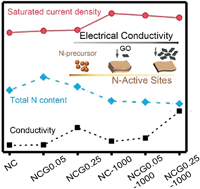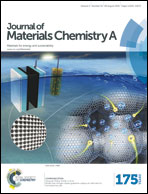Graphene/nitrogen-doped porous carbon sandwiches for the metal-free oxygen reduction reaction: conductivity versus active sites†
Abstract
The oxygen reduction reaction (ORR) plays a critical role in sustainable energy systems. Among the most promising metal free ORR electrocatalysts, nitrogen-doped carbon materials have generated significant research interest. Nitrogen doping within a graphitic/turbostratic network of carbon atoms generates active sites for the ORR via C–N bond polarisation that induces a reduced energy barrier towards the ORR on the adjacent carbon atom. At the same time, nitrogen doping leads to an increased electrical conductivity due to electron excess in the delocalised π-system. Thus, the electrical conductivity and the number and the nature of the active sites are two important factors determining the performance of nitrogen-doped carbons in the ORR. Herein, N-doped nanocarbon/graphene composites were carefully designed, synthesized, characterized and tested as electrocatalysts in the ORR in order to decouple these two factors and investigate the underlying relationships between them. Chitosan was used as a nitrogen precursor for nanocarbon, while reduced graphene oxide was introduced to tune the electrical conductivity. Our results show that a low conductivity limits the exertion of active sites and results in a conductivity-dependent ORR activity. However, when the conductivity reaches a critical value, the active sites can be fully utilized and contribute to a positively correlated ORR activity.


 Please wait while we load your content...
Please wait while we load your content...